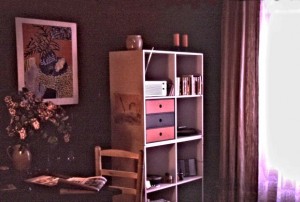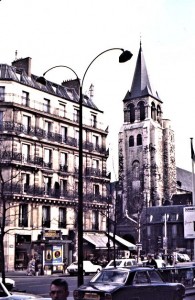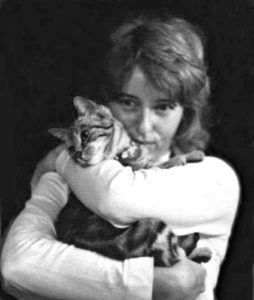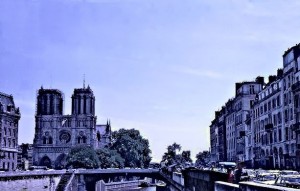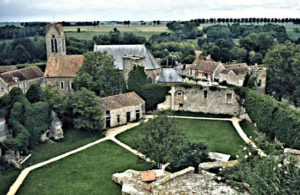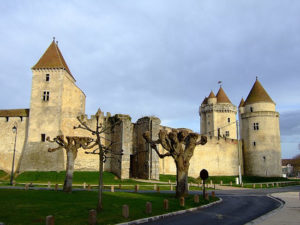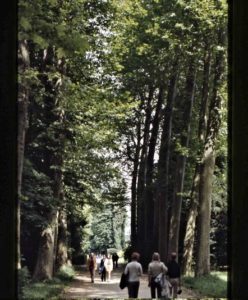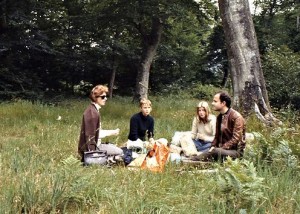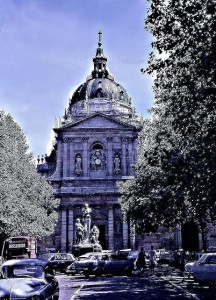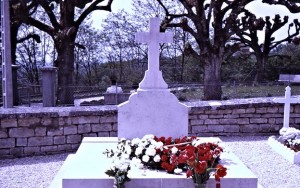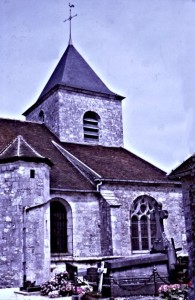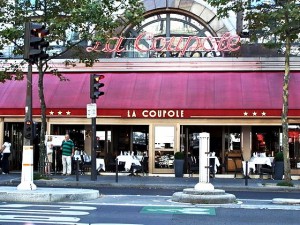Chapter 20 – My fourth life begins
Arne once told me about the La MaMa theater from New York City, an off-Broadway company, an avant-garde theater group that toured the western world. He said I must not miss them if they came to Paris. In 1970 I was alone in Paris after my second marriage had gone sour and Allyn and I had a legal separation.
I had been extremely lucky finding a job teaching English to computer science students in a new program that was being installed at Université Paris–Sud, in Orsay, a southern suburb of Paris. The salary was not very generous, but I could live on it and pay for the very nice little studio I had found in the 5th arrondissement on the Left Bank. That is where one wants to live if alone in Paris. I had enough money to buy a tiny second-hand Renault, called a 4L – L for luxe!!!
Quel luxe! The car vibrated when there were four people in it or when I went beyond 90 km/hour. But it took me where I wanted to go. Even to Sweden and back!
Virtually the first things I bought for my studio were a radio and a record player that could be plugged into the speakers of the radio. My first two records, from a local small record store, were Beethoven’s violin concerto with Yehudi Menuhin and – believe it or not – old Mr. Furtwängler as director, an excellent recording, and Ravel’s Daphne and Chloë.

One corner of my nice little studio on rue Jean de Beauvais, 5ème. Paintings by my niece 7 years old, and on the right by niece 14 years old.
One day I opened my weekly copy of L’Officel des Spectacles and found that La Mama theater was in Paris and had a play on. It was “Carmilla”, which is called a chamber opera and was created by their artistic director Wilford Leach. It is based on a vampire story by Joseph Sheridan Le Fanu.[1. ‘Carmilla’, composer Ben Johnston and late librettist-cum-director Wilfred Leach’s chamber rock opera, after Joseph Sheridan LeFanu’s vampire novella, was first given by La MaMa in 1970 and has been offered periodically since then. It was written 26 years before Dracula]
I decided to go the same evening. The theater was Le théâtre du Vieux Colombier in the 6ème arrondissement, in Saint-Germain-des-Prés, not too far from my little studio. I bought my ticket and went to find my seat. A young man was sitting on the seat next to mine. I gave him a big smile and he held down the seat for me. I was amazed. On the way out he asked me in his best French if I had the program. He knew I did. Hearing his very noticeable other-side-of-the-ocean accent, I came back immediately with a not very flattering ‘Oh, you’re American!’. We said a few polite words about the play and then he asked me if I would like to go for a cup of coffee somewhere. Of course I would.

Le Café les deux magots, Boulevard Saint-Germain. Sartre & Simone de Beauvoir in memoriam — among others.
We went to Le Café les deux Magots right across from l’Eglise Saint-Germain-des-Prés, in the very heart of bohemian Paris. The young man asked me what I would like and I said ‘Oh… a Scotch please’.
John, for that’s who it was, told me afterwards that that’s what made him think that ‘Wow, steady now. This woman has to be treated carefully.’ A Swedish woman who asks for a Scotch rather than coffee. I was wearing a nice dark blue suit with a miniskirt and, as the story goes, he couldn’t concentrate on the play because he was fascinated by my miniskirt. As he accompanied me back to my studio, a nice little walk, he asked me if I would like to go to a restaurant the following Saturday evening.
John was a physicist having a three-year post-doctoral post at Collège de France, situated in rue des Ecoles right next to La Sorbonne in le Quartier Latin. Le Collège de France is not a college at all, but mainly a very prestigious research center [1. Le Collège de France dates from the 16th century, le Grand Siècle, and it was founded for teaching purposes, making up for what was lacking at the Sorbonne. It still today actually offers some very high-level teaching in various disciplines.] in the 5th arrondissement. Well, my loneliness was over.
In John’s small two-room apartment, on rue des Saints-Pères in the 6th arrondissement also on the Left Bank, I got to know John’s adorable little kitten, who was called Mélisande after Debussy’s opera, which we saw later in Vienna with John’s parents. Pelleas UND Mélisande, said the program and we were a bit worried that it was going to be sung in German. But we needn’t have worried.
John had cassette tapes of his favorite Mahler symphonies. I remember that he had Mahler’s 1st, 3rd, 4th and 5th . I didn’t know Mahler at the time, but I fell in love with all of them.
However, maybe most of all maybe I fell in love with Mélisande. It got to be a love story. She very soon became my cat as much as John’s. If he was jealous he didn’t show it. John himself wasn’t bad either.
Mélisande traveled by air twice across the Atlantic in a cat bag and once she got lost under some seats in front of us. Everybody took it well, there was much laughter and she was soon restored to the lap where she belonged. She stayed with us until we don’t know what caught her and she left us in 1981. We did our best to keep her warm in covers and warm bottles, but there was nothing we could do to save her. The vet had said as much and she was right. Mélisande died in John’s arms.
______________________
But back to Paris. – During that spring John and I traveled quite a bit together in my little Renault – Bretagne, Le Mont Saint-Michel, Normandy and other places closer to Paris. Les châteaux de la Loire we visited later.
ngg_shortcode_0_placeholder” order_by=”sortorder” order_direction=”ASC” returns=”included” maximum_entity_count=”500″]
Also of course we went to a number of good restaurants. John is a true gourmet — and also an excellent cook. The historic Alsatian Brasserie Flo was one of these “special” restaurants. It is located not far from Gare du Nord and Gare de l’Est, at the “Court of the little stables”, la Cour des Petites-Ecuries, one of those adorable Parisian street names. It was and still is a very ‘in’ restaurant – oysters being their specialty. The ambiance is fabulous and also very noisy, and the waiters work so hard that we once saw one of them preparing a salad at a side counter for some guests, and we noticed the sweat dripping from his forehead into the salad. Hmm. Luckily it was not our salad. Brasserie Flo is situated up north quite a distance from our usual habitats on the Left Bank. We usually took the metro to get there, metro stop Château d’Eau. But one beautiful evening we decided to walk back to the Left Bank. You follow rue du Faubourg Saint-Denis, then rue Saint-Denis — with the ladies of easy virtue who were out to get John in spite of my being next to him — all the way down to Place du Châtelet and the Seine.
We crossed l’Île de la Cité and we got to Place Saint-Michel. We were close to home. That was no doubt the longest walk either one of us had taken in Paris, more than five kilometers for sure. But we were young and the evening was glorious and I must have been wearing sensible shoes.
Another one of our favorite restaurants, when we felt like spending a bit more than usual was Chez Maître Paul, just south of Place de l’Odéon in the 6th arrondissement. John had found this quite small but very special gourmet restaurant before he knew me and now we got to be known customers there. The cook and ‘le patron’ whose name was Paul Gauguin – no kidding – was a culinary artist and his wife served the tables. And perfect service it was. She had a lot of style and Maître Paul had a wonderful touch for gourmet cooking. I am pleased to see that the restaurant still exists, under the same name, but certainly not with the same couple running it.
John was prone to some exaggerations in eating at the time in Paris and he would order first filets de sole in a wonderful sauce au vin jaune (John makes them himself now, just about as good, but not with vin jaune), followed by ris-de-veau (sweetbreads) that was heavenly. Then dessert of course, and even if you skipped the salad course and the hors d’oeuvre, it got to be a bit too much for a Swede like me. John too realized after some time that he had definitely been going too far in his happy gastronomic extravaganza.
We later came back to Chez Maître Paul when we had come to live in Paris permanently, from 1973 on, both with John’s parents and with my sister Gun. We also recommended the restaurant to John’s Aunt Ann and Uncle Larry, who were delighted.
Actually, the funniest memory of that restaurant was seeing the ladies going upstairs on a very see-through spiraling iron staircase to get to the upstairs dining room. Maître Paul himself would be there, after finishing his cooking chores, standing at the bottom of the stairs looking up at the ladies receding upstairs — anyway the young ones. We usually wore dresses in those days, at least for an evening out. We just laughed at him and did not really mind. Monsieur Gauguin was a character.
I want to mention once again a much more ordinary, but very pleasant restaurant in its own way, also close to John’s studio – the Restaurant du Dragon in rue du Dragon. It was a place where people went just to have a good evening meal without any pretensions. Two elderly ladies ran it and, sadly, it does not exist any more.
The little food stores and restaurants in Quartier latin and Saint-Germain des Prés of my youth have given room to fashionable stores for the young and the jet set. The intellectual-bohemian touch of this area is gone and tourists have come in its place, first attracted by the fame of existentialists and artists, no doubt.
Back to Restaurant du Dragon, we will never forget how one of the two elderly ladies who ran the restaurant, went to get our cloth napkins – to find that one of the two cats was lying on top of the pile of napkins in a sideboard. She carefully lifted up the big cat, got the napkins out from under her, put the cat back and closed the sideboard.
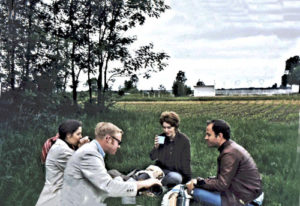
Picnicking with Jim and Sandy. we are in the neighborhood of the dilapidated château Blandy-les-Tours. Camera placed on the car.
At the end of April two of John’s oldest friends from the U.S. came over, mainly I believe to visit John, but they had first been to Italy. I believe they were also going on to England after Paris and our little trips around the “center of the world”.
We of course went to some good restaurants with our friends too, visited museums and all the things one does on a first visit to Paris.
One nice spring day we picnicked on the side of the road after having visited the beautiful château Vaux-le-Vicomte, from the 17th century, south-east of Paris, quite a distance in my little Renault. We put John’s camera on my little car and the aiming didn’t get to be quite right, so we all got to be cut off in the front. Well, there we are anyway. It was on this trip that we realized that with four people inside, it was definitely not a very comfortable car. It started vibrating seriously as soon as you got above 70 or so. But it took us to where we were going and, later on in the summer, it even took us to Sweden and back
From Vaux-le-Vicomte we went on to the Château Blandy-les-Tours, once a real fortress. It dates from the 14th century and with some imagination you can see that even what was left was very impressive. At the time, however, the entire château was quite run-down. It has since been reconstructed and it looks fabulous in photos.
It was very lucky for me that I got to know Mossy (John’s nickname for Jim) and Sandy, who was at the time highly pregnant with their third child.
The year I got back to New Rochelle I was very lonely, and since Jim and Sandy lived in Willow Grove, a suburb of Philadelphia, it was great being able to get in my car (a Volvo now) and drive to Philadelphia, which I did several times. I will never forget once as I turned the corner into their street, little Maggie, their oldest child with flaming red hair, came running towards me to welcome me. Maggie and I became fast friends. The first time I came to visit, little Michael was born and was already sitting up in his baby chair. Steven, in the middle, was to become a real athlete.
ngg_shortcode_1_placeholder” order_by=”sortorder” order_direction=”ASC” returns=”included” maximum_entity_count=”500″]
Back to Paris now — at the beginning of June 1971 our niece Kajsa and her friend Kerstin came to Paris to stay for about a week. I moved to John’s studio in rue des Saints-Pères and left my place to the girls. We had managed to borrow a mattress somewhere and I remember they had brought some kind of paper sheets from Sweden.
We traveled around quite a bit, Versailles of course and le Château de Fontainebleau in the beautiful Forêt de Fontainebleau south of Paris. I remember how, on our return from Versailles during the heure d’affluence, the rush hour, when lots of people were already heading home from work, Kajsa was amazed at my patience. There were no end of traffic jams and Kajsa said she couldn’t believe how I could stay so calm in the nerve-racking traffic. I said I had probably become used to it around New York City.
In Fontainebleau John was with us and we took another one of those pictures where the camera was sitting on the car. It worked out much better this time, even though you can’t really see the faces of the two pretty girls. We took them to restaurants too of course and I believe they had a good time. It was their first visit to Paris, which Kajsa would get to know so well a couple of years later. She was to become a student at the Sorbonne, taking the courses for Langue et Civilisation Françaises, even two years in a row.
__________________

Richard Guston at his standard café and restaurant, Le Commerce, being interviewed after he has just turned 90
I must not forget to mention my friend Richard Guston, who was an outstandingly original character and also usually a lot of fun. That is if he didn’t half-way smother you with pretty nasty one-liners when he felt like making fun of you. He was a foreign correspondent for two major Swedish newspapers at the time, Göteborgs Handels och Sjöfarts-Tidning (Gothenburg Commerce and Maritime newspaper) and Sydsvenska Dagbladet, the paper most people in Malmö and Skåne subscribe to, and probably large parts of the rest of southern Sweden as well. Handelstidningen (the Commerce paper), as it was usually called, shut down in 1973, but in 1971 when I first got to know Richard at Svenska klubben at a Christmas party, this outstanding newspaper was still going strong.
About Handelstidningen though, it is very much a newspaper with a lot of history. During World War II, most Swedish neewspapers, almost all, did not dare say a critical word against the Nazis to whom we allowed free passage by train through Sweden to Narvik in Norway and also in many other ways supported. There was only Handelstidningen in the person of its editor-in-chief, Professor Torgny Segerstedt who is “most remembered for his uncompromising anti-Nazi stance and his efforts to alert the Swedish public to the threat of Fascism during the 1930s”.(Wikipedia) I would add that his anti-Nazi stand went on during the war.
At the Swedish Club Christmas party Richard invited me to dance without being the least concerned about his wife, Lucette, whom John and I later got to know. She was sitting with other non-dancing ladies in another room. She didn’t look too happy, but she seemed to be used to Richard dancing with young Swedish women.
Richard was not a Casanova, but he was very witty and entertaining, mainly because of all the things he knew about what was going on in the world. His sharp wit could be entertaining, but he he had no qualms about using his wit in a hurtful way. He was a former athlete, football and basketball and I just learned the other day that he had been French champion in basketball – twice. The other day I found an article in Swedish on the Internet about “Legendary Parisian met Malcolm X in Harlem… journalistic legend Richard Guston turns 90”.
Richard had done his graduate studies at la Sorbonne, studying film and he was an inveterate movie freak. There was no way you could study film in Stockholm or any Swedish university in those days so his mother gave him a generous monthly allowance to go to Paris to study his favorite subject. It was during those years that he got to be a basketball champion and I know he also played football. John and I once went to an excellent Greek restaurant with him, owned by a former football team mate of his. Greek restaurants abound in le Quartier Latin, but Alexis’ was definitely at the top, and it was also set apart from all the very touristy and more or less phony Greek restaurants in the 5ème. Alexs’ restaurant was on the west side of Boul’Mch.
One of Richard’s absolute favorite movies was ‘Barefoot Contessa’ with Ava Gardner. He was definitely in love with her. Paris is probably more or less unique as far as old movies are concerned. There are quite a few movie theaters that run old movies regularly. Rue Champollion in the 5th arrondissement is one street with quite a few of those theaters, and I really didn’t know that dear old Action Christine in the in the 6ème was Richard’s favorite until I read the Swedish article about him the other day. Nor did I know that he had actually met Malcolm X in Harlem.
However, I managed to see ‘Barefoot Contessa’ that spring and I see why Richard has such a crush on Ava Gardner. And, by the way, Richard would sit in the front row when he went to the movies, to be as close to the screen as ever possible.
As it happened, Göteborgs Handels och Sjöfarts-Tidning (Göteborg Commerce and Marine newspaper) shut down in 1973. It was most likely too intellectual to sell as well as the other Swedish major newspapers.
I asked Richard when we got back to Paris that year if he now made less money. He said “No, I make more”. Well, Sydsvenskan, as we call it, must have a very good economy. Of course Richard deserved it. He was truly an exceptional foreign correspondent who covered the entire Western World. And more, in fact.
We actually lost trace of him before we left Paris in 1986. I suppose that some fierce arguments, one loud one at Brasserie Balzar, got to be too much and we didn’t feel like arguing with him again.
There was also another pretty silly argument, but not so loud, about the Cathedral in Lund. I may have said that it was my favorite church building and mentioned its gorgeous Romanesque architecture. He shot back instantly that Lund Cathedral is Gothic. What??? Had he never been to Lund? Ever? He told me he had graduated in the history of art and he knew well the difference between Gothic and Romanesque architecture. I said so did I, and I got quite upset by his know-it-all attitude since he was clearly so very wrong. I went to Galignani’s bookstore in Avenue de l’Opera (No Internet in those days) and found very easily a book on Romanesque churches, or on Swedish churches, or whatever. I copied what it said about the beautiful Romanesque Lund Cathedral and showed it to him the next time I saw him. He did seem a bit embarrassed. He was definitely not used to being wrong.
I asked Richard once if he’d like to come to John’s place for Swedish meatballs. Typically for Richard, instead of thanking me for my friendly invitation he said “If there are lingonberries to go with them”. So we had to somehow find some lingonberries, probably at IKEA. I prepared the meatballs, and past the time of the invitation we were beginning to wonder where Richard was, when we heard a desperate cry from the street John John, or rather, in Richard’s Swedish pronunciation, Yon Yon. We looked out through the window and there was Richard standing all forlorn in the middle of the empty rue des Saints-Pères. He remembered the street, but he had not remembered the number of the building and so he was all lost. Well, we saved him. And the meatballs were good. I don’t remember if he said so. But John definitely did.
Richard once suggested to me, before I knew John, very well at least, that I drive him to Colombey-les-Deux-Eglises where Charles de Gaulle lived and died and Is buried. Richard never had a car and didn’t know how to drive, and did not feel the need for a car. It was a little pilgrimage to a man’s memorial who was certainly a good man as well as an extremely proud man.
De Gaulle had died just a couple of months earlier — 9 November 1970 — and Richard had been wanting ever since to see his tomb. It was of course decorated with gorgeous flowers. De Gaulle can be blamed for not putting an end to the Algerian war much sooner, but he can also be praised for finally ending it in 1962 in spite of strong patriotic feelings among the French for l’Algérie française. The Algerian war had been a highly emotional divider between pro and con in France for many years, but after 1962, things settled down and peace was restored. No more bombing of bookstores in the 5ème that openly supported l’Algérie pour les Algériens.
In the summer of 1962, when the Algerian war was finally over, I got to Paris with my Norwegian-Swedish Stockholm roommate, Brita (or apartment mate, more accurately). We arrived on July 13, the evening when people dance in the streets and celebrate le 14 juillet, la fête nationale. This was the first time since the beginning of the Algerian war and World War II that people were dancing in the streets all over France. It was pure joy that the long national oppositions concerning the Algerian war could finally be laid to rest. The French knew perfectly well about the horrible torture that both sides were equally guilty of, even though most people would never openly admit it. Brita and I heard the music and noise on the Grands Boulevards from where they begin in front of l’Eglise de la Madeleine and go east from there. Our little hotel was just behind la Madeleine. Brita went back to the U.S. after this brief visit to Paris, and I went on to le Midi, the south of France.
About Richard’s sharp wit that could sometimes be offensive, I was once having dinner with him and a young Swedish woman whose name was, funnily enough, also Siv, a not very common Swedish name. I suppose I mentioned Arne’s name a bit too often, at least in Richard’s opinion. At one point this other Siv asked “Who is this Arne you keep talking about?” Richard had an instantaneous killer comeback and said “En kulturknutte från Katrineholm” (vaguely: “a culture freak from Katrineholm”) I admit I had mentioned that Arne had received the yearly cultural prize in Nyköping where he and my mother lived after leaving Malmö and the theater. I may also have mentioned Arne’s name a bit too often, since he has indeed said so many things that are of interest and worth repeating. Be that as it may, I probably deserved being made fun of, but Richard’s sharp réplique was definitely an insult to me. He knew first of all that my parents lived in Nyköping, not Katrineholm, which is another not very big city south of Stockholm.
Richard grew up in Stockholm, came from a wealthy family and went to school at Sigtuna boarding school, which is the school where the present Swedish king also went as well as the sons of some super-rich and show-off families. Besides his probably intentional confusing of small cities close to Stockholm, the word, “knutte” is distinctly condescending, especially for a grown-up man. Still, I forgave him, even though I was mad at him at the time. I must have enjoyed his company after all, in spite of his sometimes sharp tongue. His political columns were excellent and I suppose I was impressed by his intellect.
I saw quite a bit of Richard during the spring, with and without John, but mostly with of course, after John and I had established a firm relationship. Richard took me to la Coupole, one of the historic Paris restaurants on Boulevard Montparnasse. It is one of those restaurants that either you love it or you simply dislike it. You could say it looks like a railway station or you can say that it looks like a meeting place for all sorts of famous people, artists, intellectuals and skinny models who eat half portions or skip most. Richard loved Coupole. He saw it as the center of the world. Since he knew the waiters and always had the same table he was treated as a very special guest and of course I got to share that special treatment. I remember I always had fish and Richard ordered a bottle of Sancerre for me, without asking my opinion. That was fine with me. It couldn’t be better. Richard himself never ate fish nor ever drank white wine.
And there was Brasserie Balzar in rue des Ecoles, right next to La Sorbonne, another one of Richard’s favorite restaurants. John and I, a bit later on, got to have our favorite waiter so we would, when making reservations, always ask for one of Richard’s tables. Yes, that was his name too. He later opened a restaurant of his own. That waiter we inherited from Richard Guston too. The waiter Richard was wonderful. He would, for instance, give us extra marrow bones when we were eating boeuf daube. Later, when we came back to Paris, Balzar without Richard was never the same.
You always saw one or two professors from la Sorbonne who would come in and have a choucroute and nothing else and be gone before we had started eatingt. Pretty young women were not lacking here either. It is a small place, especially compared to La Coupole, but it certainly had and has its very special charm and clientèle.
Continued: Chapter 21 – Travels with John in the summer of ’71

